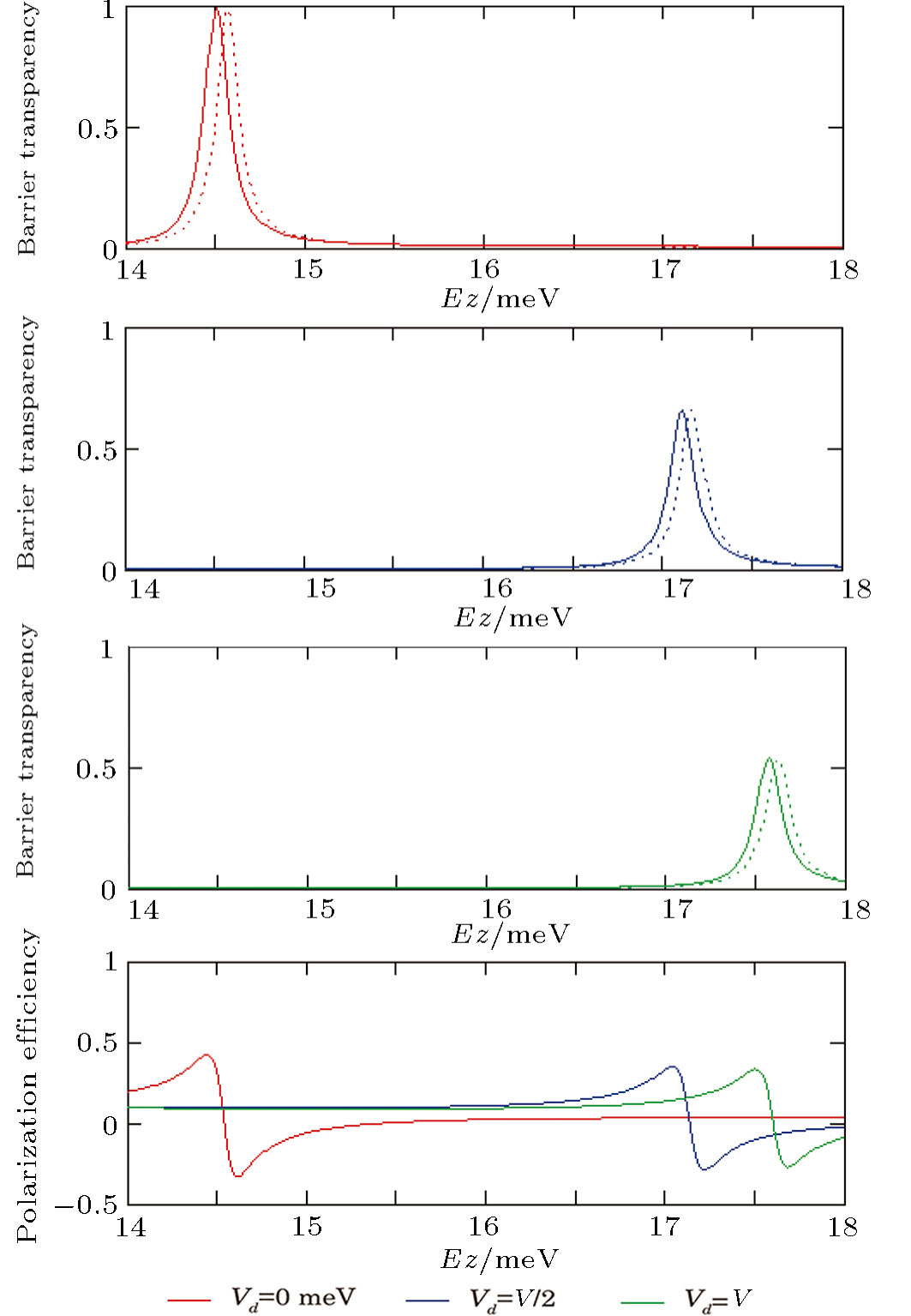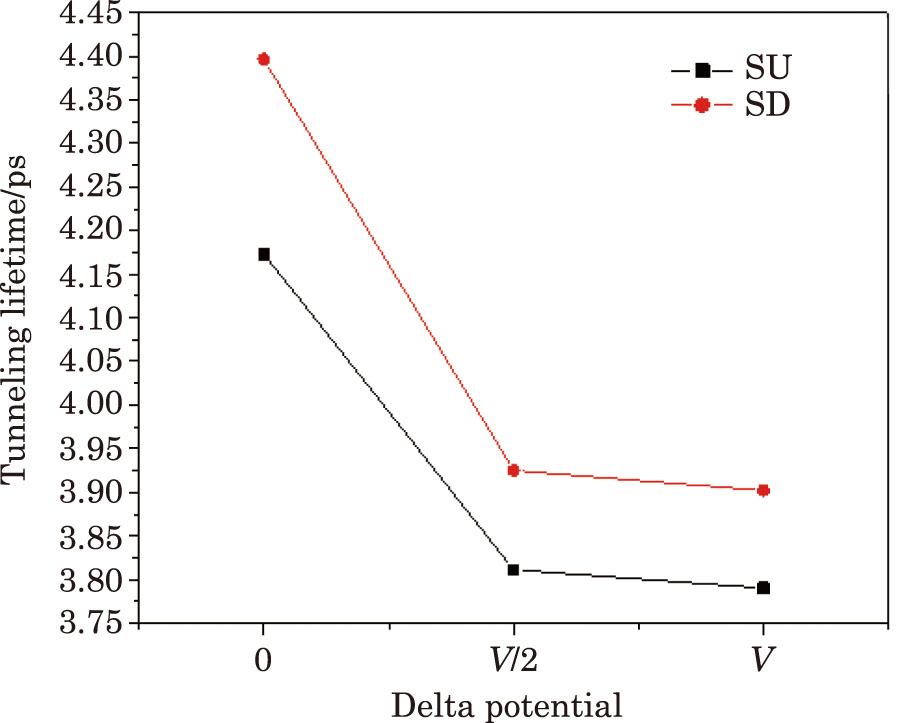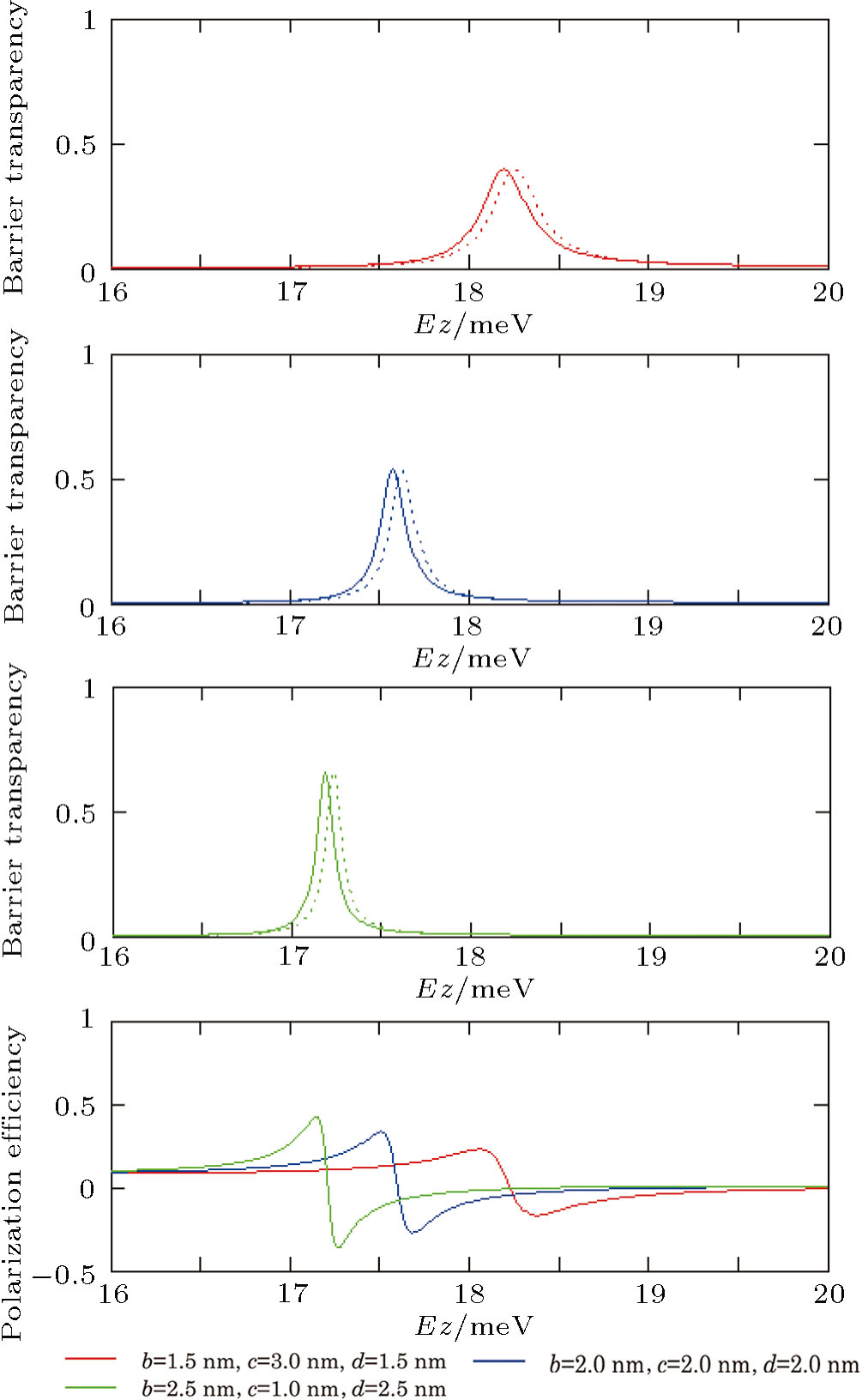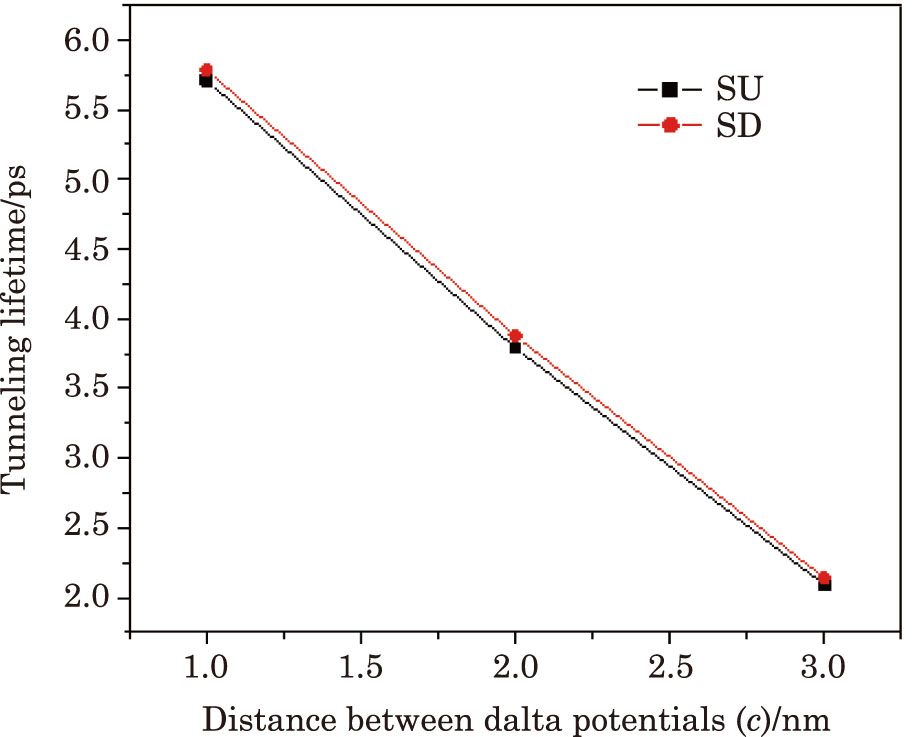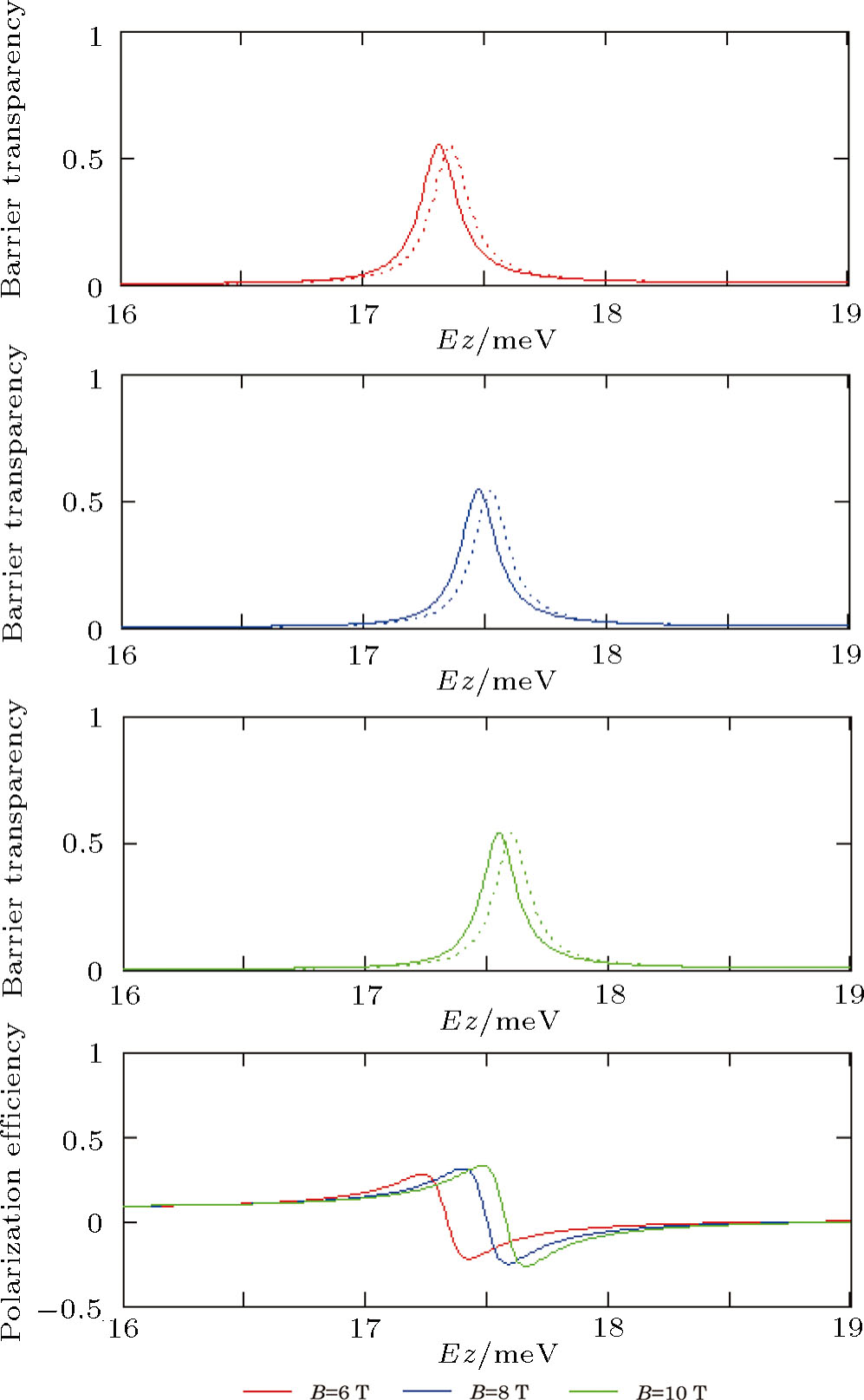† Corresponding author. E-mail:
Using the matrix method, spin-dependent tunneling properties such as barrier transparency, the degree of resonance polarization, and tunneling lifetime of electrons are examined in the non-magnetic/diluted magnetic semiconductor heterostructure. The effects of the double
Spin-transport properties in low dimensional systems have been attracted worldwide due to its technological important applications such as spin-quantum computers and spin-transistors.[1,2] Moreover, the basic physical characteristics of spin-dependent charge carriers through the heterostructures such as Hartmann effect, dwell time, spin-flip scattering, BGKC observation and delay time encourage this research.[3–6] The effective spin injection in semiconductors is still a challenge out of few. Spin injection in semiconductor from a ferromagnetic conductor is one of the choices for the effective injection. But the growth of ferromagnetic conductor on semiconductor and the conductivity mismatch leads the research community to find another possibility. Later, the spin injection from the semiconductor to the semiconductor is proposed. After the proposal given by von Ortenberg, Mn-based superlattices are examined by various research groups.[7–12]
Papp et al. reported the spin-dependent tunneling of electrons in asymmetrical heterostructures using transfer matrix method. In the multilayer heterostructure ZnSe/Zn1−yBeySe/ZnSe/ZnxMn1−xSe sharp resonance peaks for spin-up electrons and suppressed transmission for spin-down electrons are observed with zero bias, whereas in ZnSe/Zn1−zCdzSe/ZnSe/ZnxMn1−xSe heterostructures wide resonance peaks for spin-down electrons and suppression for spin-up electrons are observed. These structures with the suitable fields are proposed for spin filter and spin diode.[13] Saffarzadeh et al. analyzed the effect of bias voltage and barrier thickness in ZnSe/Zn1−xMnxSe symmetrical and asymmetrical heterostructures. The transmission coefficients for the electron energies, which are near the Fermi energy increase as the bias voltage increases. The current density for spin-up electrons increases when the thickness of the non-magnetic ZnSe layer increases. Moreover, the current density for spin-up electrons in the asymmetrical heterostructure is higher than the symmetrical one, but for the spin-down electrons, it does not change considerably.[14] Gnanasekar et al. reported the effect of induced-Rashba due to the external electric field in ZnSe/Zn1−xMnxSe double-barrier heterostructure. The spin-up electrons are completely blocked and spin-down electrons are almost transmitted when the CBO is either zero or positive values. Four times enhanced current density is also observed in the heterostructure when the electric field induced Rashba is accounted.[15]
Alireza Saffarzadeh analyzed the effects of “Mn” concentration on spin-polarized transport through ZnSe/Zn1−xMnxSe heterostructure with single paramagnetic layer. When “Mn” concentration is low the spin-down current density decreases whereas the spin-up current density is almost a constant. This is true for all value of bias voltages. But when the “Mn” concentration is high the spin down current density increases, whereas the spin-up current density decreases exponentially.[16]
Ming et al. examined the ballistic transport of electrons through ZnMnSe/ZnSe/ZnBeSe heterostructures. The negative differential conductance in the triple barrier heterostructure is observed, and it disappears when the bias voltage is large. Moreover, the polarization rate exhibits high values of the degree of spin polarization.[17]
This paper reports the effect of magnetic field and δ-potential on the spin-transport in ZnSe/Zn1−xMnxSe symmetrical double-barrier heterostructure. The effect of δ-potential in non-magnetic semiconductor heterostructure is reported in the literature.[18–20] But from our best of knowledge, the effect of δ-potential on spin-transport in non-magnetic/diluted magnetic semiconductor heterostructure with the magnetic field is not available. This induces us to find the barrier transparency, polarization efficiency, and tunneling time of electrons in ZnSe/Zn1−xMnxSe heterostructure with double δ-potential as a function of the height of the δ-potential and its position. The theory and the formalism are given in Sec.
We consider spin-dependent electrons tunneling through double paramagnetic barriers with the external magnetic field. It is assumed that the magnetic field is applied along the motion of the incident electrons, i.e., along the z-direction.
The effective Hamiltonian of the system can be written as


The effective potential of the heterostructure when the external field is applied is given as 

VZ(B) is the Zeeman splitting and VGZ(B) is the giant Zeeman splitting and is given as, respectively, 






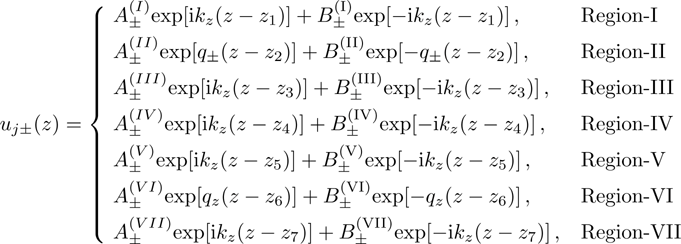


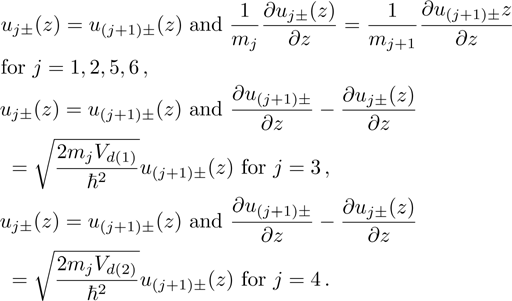
According to the boundary conditions, the coefficients are related as

The transmission coefficient of electroncs in the heterostructures is 

The full-width at half maximum of the barrier transparency peaks are found and the tunneling life time of spin-dependent electrons are calculated using the Heisenbergʼs uncertainty principle.
ZnSe/Zn1−xMnxSe double barrier heterostructure is considered with identical barriers in terms of barrier width and barrier height. The parameters used in this work are listed: 



Figure
The introduction of the δ-potential in the non-magnetic semiconductor/diluted magnetic semiconductor heterostructure influences the tunneling lifetime of the charge carriers. Exactly speaking, the introduction of the δ-potential reduces the tunneling lifetime of electrons in the ZnSe/Zn1−xMnxSe heterostructure, whereas it is almost the same in the case of non-magnetic semiconductor heterostructure.[20] Figure
Figure
The application of the magnetic field increases the effective potential of the heterostructure due to the giant Zeeman effect. The barrier transparency and the polarization as a function of the applied magnetic field are given in Fig.
The increasing magnetic field shifts to the resonance energy to the higher energy. Moreover, the enhanced polarization efficiency is achieved due to the high magnetic field. The tunneling lifetime of spin-up electrons is 3.528 ps and for spin-down electrons is 3.586 ps, when the applied field is 6 T. From these numerical values, it is observed that the tunneling time of spin-down electrons are higher than spin-up electrons. But the difference is very small. The tunneling of spin-electrons increases as the magnetic field increases. When the applied field is high, the effective potential increases due to the enhancement of Zeeman and giant Zeeman effect. Hence the tunneling lifetime of electrons is also increased, but the variation is very small. This is in agreement with the reported results.[22]
In short, the degree of resonance polarization (i) decreases as the height of the delta increases, (ii) increases as the distance between the delta potential decreases and (iii) increases as the magnetic field increases.
The spin-dependent transport properties are reported using the transfer matrix method. Suppressed barrier transparency is observed due to the introduction of the δ-potential and it leads to the reduced polarization efficiency. High polarization efficiency is achieved when the distance between δ-potential is minimum. The tunneling lifetime of the electrons highly is influenced by the δ-potentials. These results can be useful for the fabrication of spin-based devices.
| [1] | |
| [2] | |
| [3] | |
| [4] | |
| [5] | |
| [6] | |
| [7] | |
| [8] | |
| [9] | |
| [10] | |
| [11] | |
| [12] | |
| [13] | |
| [14] | |
| [15] | |
| [16] | |
| [17] | |
| [18] | |
| [19] | |
| [20] | |
| [21] | |
| [22] |



